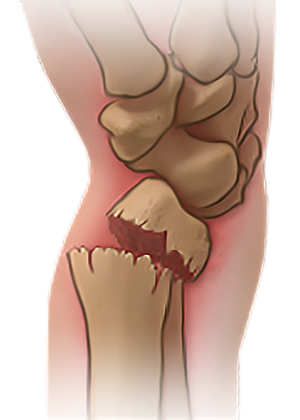What is a Wrist Fracture?
 When we think of a wrist fracture, most of us don’t realize there are several places in the wrist that we can injure. However, the most common of these is the Colles’ fracture. Broken bones are very common, although a broken wrist is the most prevalent. Moreso than ever, every 10 cases of a broken bone is in the wrist. Typically such injuries occur from falling on an outstretched arm or getting hit.
When we think of a wrist fracture, most of us don’t realize there are several places in the wrist that we can injure. However, the most common of these is the Colles’ fracture. Broken bones are very common, although a broken wrist is the most prevalent. Moreso than ever, every 10 cases of a broken bone is in the wrist. Typically such injuries occur from falling on an outstretched arm or getting hit.
A wrist fracture is most commonly found in people who participate in contact sports, also skaters, skiers, and bikers. However, elderly people who have osteoporosis are at very high risk for a wrist fracture.
Symptoms of a Wrist Fracture
When experiencing a broken wrist, many patients have confirmed symptoms, such as:
- Wrist pain, especially when flexing the wrist.
- Deformity of the wrist.
- Swelling
- Tenderness
- Bruising
Although uncommon, sometimes a wrist fracture can affect the nerves or blood flow. Immediate medical attention is required if symptoms occur, such as:
- If your fingers are pale.
- The wrist is in great pain.
- Your wrist, arm, or hand is numb.
Causes & Risk Factors of a Broken Wrist
When experiencing a broken wrist, there are many different causes. However the most common are as follows:
- Falls. Falling onto an outstretched hand is one of the most common causes of a broken wrist.
- Sports injuries. Many wrist fractures occur during sports in which you might fall onto an outstretched hand — such as in-line skating or snowboarding.
- Car Crash. Motor vehicle crashes can cause wrist bones to break, sometimes into many pieces, and often require surgical repair.
When you participate in sports, you are at greater risk of an injury occurring. Having a bone-thinning disease, such as osteoporosis, however, also can increase your chance of breaking a wrist.
The following sports activities can leave you at greater risk:
- Snowboarding
- In-line skating
- Jumping on a trampoline
- Horseback riding
- Hockey
- Skiing
- Football or soccer, especially on artificial turf
- Rugby
Treatment of Wrist Fracture
Conservative treatments are always first looked at. Although there are cases where surgery is required for a full recovery.
Non-surgical methods include:
Medications:
Over-the-counter pain relievers such as ibuprofen will help with pain, swelling, and inflammation.
Depending on the severity of your fracture, your doctor might prescribe an antibiotic. This is especially the case if you have an open wound.
Immobilization:
It is critical for proper healing to restrict the movement of a broken bone. A splint or case is likely to recommend to keep the bone in place.
Physical Therapy:
After your cast is removed, physical therapy is a good option. Rehab for your wrist is an important part of healing and can take several months.
Surgical Treatment Options:
Depending on the severity, however, surgery might be required. There are many surgical options, implant pins, plates, rods, or screws to hold your bones in place while they heal. Though a bone graft might also be used to help to heal. These might be options, such as:
- An open fracture
- A fracture in which the bone pieces move before they heal
- Loose bone fragments that could enter a joint
- Damage to the surrounding ligaments, nerves or blood vessels
- Fractures that extend into a joint
If you experienced a broken wrist and are looking for relief, call us now at 888-409-8006. Schedule an appointment with a hand/wrist specialist now.
